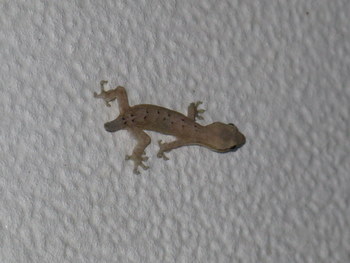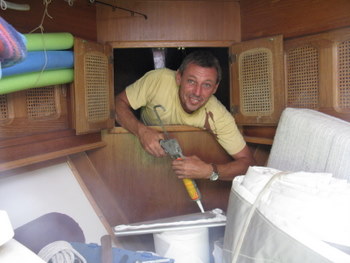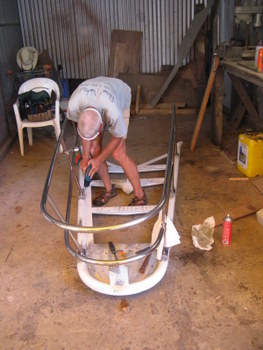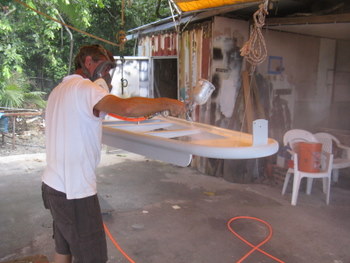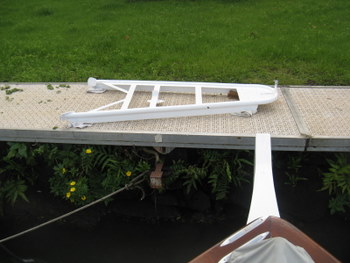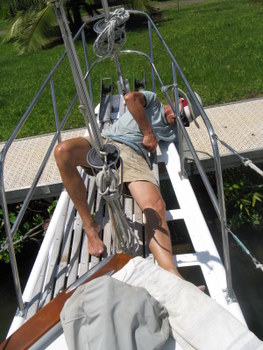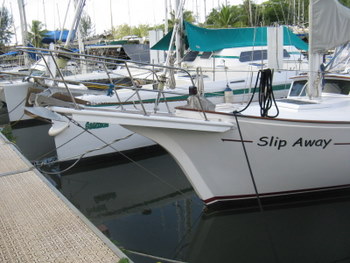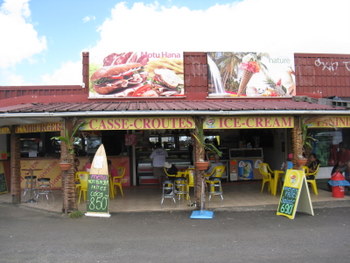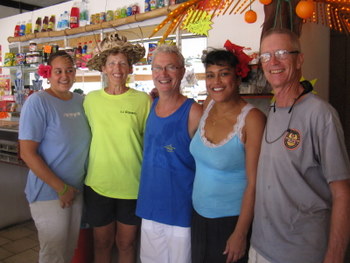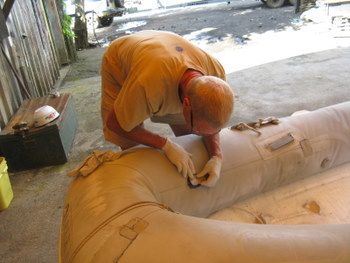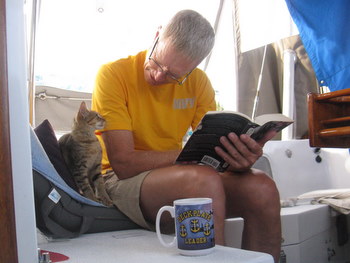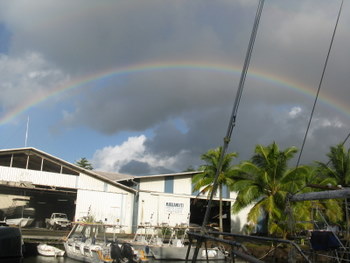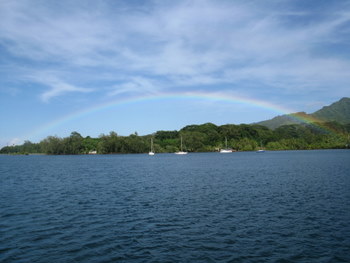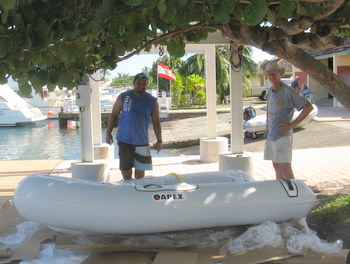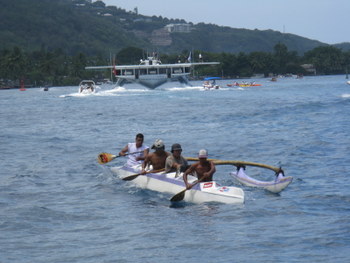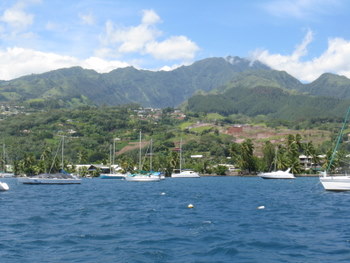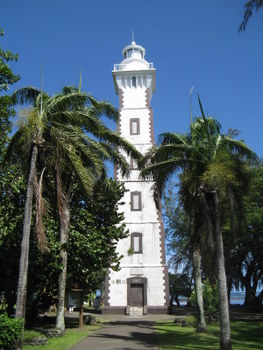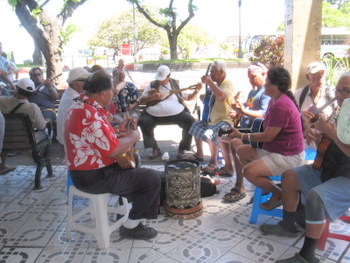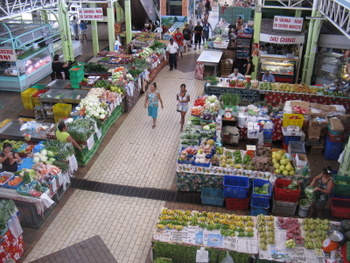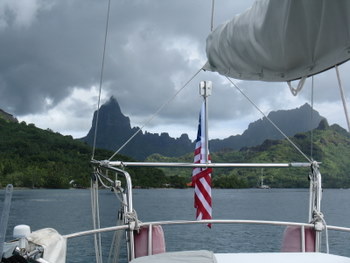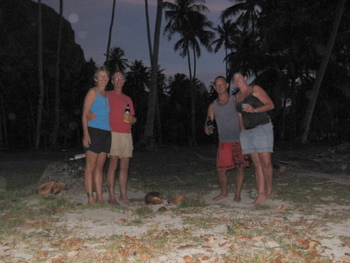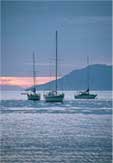
Current Location
(enter callsign KG6NNZ)
Logbook: Tahiti & Moorea - February to April 2011
After a 4˝ month visit with family and friends in the U.S., we headed "home" to Slip Away in Tahiti. We were happy to be on our way back to the boat, even knowing that we had a fair amount of work ahead of us. After having been left alone for so long, Slip Away would need some TLC, and we also knew there was a bowsprit repair project waiting for us. It took us several weeks to do the repair and then a few more to get all systems up and running again, but we finally got it together and headed out to continue exploring the beautiful islands of French Polynesia.
Return to Tahiti (February 1-2). Our flight from Los Angeles to Tahiti was an 8-hour red-eye flight, and we boarded the plane around 11 p.m. Shortly after take-off, Jan reclined her seat and went to sleep, but Rich stayed up for the free meal that was being served. The flight was mostly uneventful, with the exception of the man behind us waking Jan up by pushing her seat forward when the meal was served, telling her she was rude to have her seat reclined while they were eating dinner. If looks could kill...
We arrived in Tahiti early in the morning, claimed our 300 lbs. of checked luggage, piled it on a cart, and smiled at the Customs agents as they waved us through with no questions asked. We needed to kill about an hour of time before picking up our rental car so we wouldn't have to get up at an ungodly hour the next morning to return it. There's a McDonald's in the Papeete Airport, and we grabbed a couple of Coke Lights and split a "Croque McDoo" (a toasted ham and cheese sandwich).
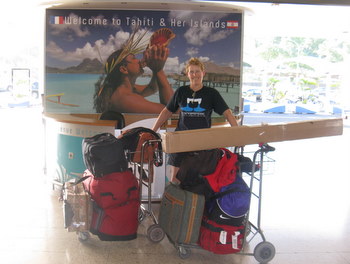 Jan with our luggage |
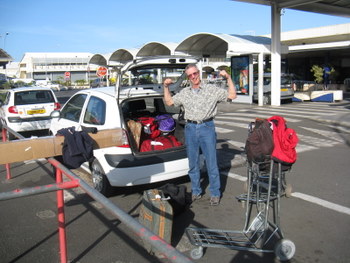 Rich successfully stows it all in the rental car |
After wasting sufficient time, we rented our car, loaded up our luggage and headed back to Tahiti Nautic Center and Slip Away. The marina is about 1˝ hours by car from the airport, it was a sunny and warm day, and the drive was beautiful. Slip Away was waiting for us at the dock, and she looked to be in good shape. We left her here in the rainiest months of the rainy season (and at the rainiest area on the island), so she had some mold on her decks and mildew on the inside, but overall, it wasn't too bad. She had fared quite well in our absence.
Before we could unload our luggage, we needed to install our main and mizzen sails because they were stored inside the boat stretching from the v-berth across the middle of the salon floor. We immediately got to work and attached them to their spars, and then we hefted the luggage on board, and dragged the bags inside the boat. Next on our "to-do" list was lunch, so we hopped in the car, drove into Taravao (just a couple of kilometers down the road) and headed to a little spot we found last year - Snack Motu Hana. After lunch, we visited the grocery store to pick up some provisions, including a case of Hinano beer which was on sale for about $35 US (for twenty 16-oz returnable bottles) - by far the best price we ever found on beer here!
After an early dinner of local delicacies - baguette, brie and paté de foie, washed down with a cold Hinano - we crashed and slept like the dead. We were up at 5 the next morning, so that we could get the car back to the airport by 7:30 a.m. After dropping off the car, we took the bus into downtown Papeete and ran a few errands. First, we walked out to the Customs office on Motu Uta to file some paperwork for Slip Away and obtain the documents that would allow us to buy duty-free diesel. We then stopped by the Port Captain/Gendarmerie offices to check in with them, and then we walked to the Immigration office to complete the registration process for our six-month visas. We were done with our errands by noon, so we found a reasonably priced cafe and enjoyed a nice lunch. After lunch, we caught the bus back to Tahiti Nautic Center.
| Tahiti Nautic Center (TNC), Taravao, Tahiti (February 1 to March
16). Our first order of business upon returning to Tahiti was to clean up
Slip
Away and get her into habitable condition. Rich went to work on the
outside, scrubbing the front deck, cabintop and cockpit, while Jan worked on the inside, wiping down
all surfaces with vinegar and water to clean up the mildew. Jan's work on the
inside included cleaning the insides of all lockers and storage areas, which was
quite helpful in terms of taking inventory of provisions, reminding us where
things were stored and finding a couple of lost items. In the cleanup process, we got rid of a few mud wasp
nests (including one plugging our water tank vent), and we had a few spiders on
board (which always happens when we're tied to a dock), but we were very happy that there appeared to
be no infestations of ants, cockroaches or other vermin. For a while, we
had a crab living in our back deck box, but over the next few weeks he moved
out. And, we did find a new pet gecko on board. He's quite shy so we
don't see him very often, but we did manage to snap a photo of him. He's a
tail-less little guy, and we named him Gaston.
After spending a few days doing some essential scrubbing on the outside, Rich got started on the bowsprit repair project that was waiting for us. Last fall, while entering the pass into Fakarava Atoll in the Tuamotus, we buried Slip Away's bow in some standing waves and sustained some damage - our bowsprit bent and the staysail deck attachment pulled out of the underlying fiberglass deck. Our bowsprit is made of aluminum, and it needed to be straightened and reinforced, and we needed some fiberglass repair work done where the staysail had pulled out. By some stroke of luck, there was an aluminum boat building operation (a division of Nautisport) next door to the TNC marina, and they were able to do the welding and repair work on the bowsprit. TNC also has a small boatyard and repair facility, and the manager Yvan helped us with the rest of the work. |
|
The repair project essentially involved dissembling everything attached in some way, shape or form to the bowsprit, removing the bowsprit, making the required repairs to the deck and bowsprit, and then putting it all back together again. We and the Nautisport welding manager agreed that the original bowsprit construction on Slip Away was not sufficiently robust, so after straightening it, they welded an aluminum bar along the bottom edge to reinforce it, and then they also welded a few other smaller items we requested (e.g. welding closed the existing bow pulpit fastener holes because the aluminum had oxidized over the past 30+ years and the threads were gone). We were also unpleasantly surprised to find that the staysail deck attachment point had no backing plate - it was attached with screws and small washers, and upon close inspection, it was apparent that this area had been previously repaired on Slip Away by a former owner. Yvan helped us install a backing plate, and he repaired and painted the damaged fiberglass. After the boatyard was done with the repairs to the bowsprit, Rich used epoxy filler to smooth out a few rough areas, then sanded it, and Yvan painted it. When all the repair work was done, Rich (with help from Jan as needed) reinstalled all the pieces - bedding the bowsprit to the hull, fastening the staysail attachment point to the deck through the new backing plate, reinstalling the bow pulpit, reattaching the headsail and staysail furlers, and finally reinstalling the anchor troughs and wooden bowsprit slats.
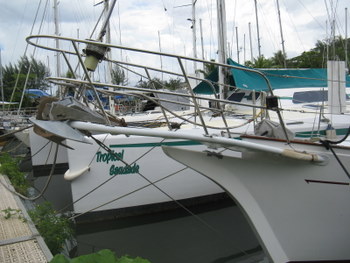 The bent bowsprit, with staysail attachment pulled out of underlying deck |
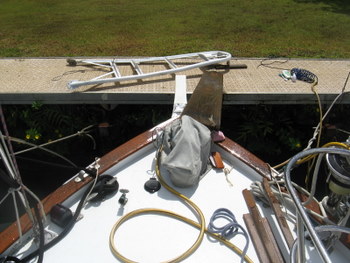 All parts dissembled |
|
|
|
|
|
|
|
|
The bowsprit repair went smoothly, but as with all boat repairs, it took some time. We ended up spending six weeks in the marina before the job was complete. We were no longer enjoying the cheap labor prices of Latin America, but we felt both Nautisport and TNC charged a fair price. Having the repair done in Tahiti was likely no more expensive (and possibly less) than what it would have cost in the U.S. We were very pleased with the quality of work done by the aluminum welders and Yvan. Slip Away's bowsprit is now much stronger and more stable, and it looks good too!
Life tied to the dock. It was no problem to live aboard Slip Away while the bowsprit repairs were being done, so we settled into our home. TNC offered only basic amenities - a bathroom and hot shower - but we don't require much. There was a wifi internet signal in the marina, which cost about $5/hour, but that's the standard rate in Tahiti - no free or cheap wifi in these islands. The electricity on the dock was 220 volt, and we did not have a transformer for our 110 volt boat, but our solar panels kept up with our daily electrical needs. We could not run our freezer, but we could run the fridge, and the grocery store wasn't far away. The water on the dock was not potable, so we did not put it in our water tank, but it rained often enough that we could catch sufficient rainwater for drinking and cooking. We used the dock water for cleaning, laundry and dishes, but we didn't wash any white laundry after it had rained hard for a few days because the water was then brownish. We did all of our laundry by hand because the only laundry we found in town charged about $1 per pound.
Every few days, we would make a run into Taravao, which was about 20 minutes away if we walked from the marina, but we often took the dinghy up into the bay, where we could tie it to a tree so that the walk was only about 5 minutes. Taravao is not a tourist center, so we were a bit of an anomaly, and the locals couldn't have been friendlier to us. When we went into the ACE Hardware store, we usually had five or six of their employees wanting to help us. The employees at the grocery stores always greeted us with a smile, and they knew that we understood the system for returning the beer bottles. We frequented Snack Motu Hana for lunch and an occasional breakfast, and the proprietors Rita and Bernard, as well as their employee Delfina became friends. We were sorry to say goodbye to them when we finally left.
|
|
|
| Rich's primary focus during our stay at TNC was to get the bowsprit repaired. When time permitted, he also did some deck and
hull scrubbing, metal polishing, re-bedding of leaky hardware and other odd jobs
which are plentiful on the boat. Jan
initially spent a lot of time cleaning the inside of the boat, which took quite
a few hours. Slip Away was
getting the best cleaning she'd had in a long time! Since cleaning isn't
one of Jan's favorite pastimes, she tried to inject some variety into her days
with sewing projects and updating our website. When we were close to departing the
marina, she picked up where Rich left off on scrubbing the outside decks, cabintops, cockpit and hardtop. Some of the deck cleaning work Rich did
when we initially arrived needed to be re-done because six weeks later, the
mold was starting to grow again. Both of us (but mostly Rich) also spent
several hours patching leaks on our 9-year old dinghy. We were fighting a
losing battle - it was quite apparent that we needed to buy a new one.
The weather while we were in TNC was mixed - some sun, some rain. When the sun was out, it was quite hot and humid. If it was cloudy, it was usually raining. We were grateful that we had only a few days of non-stop down-pouring rain. We needed to work around rainshowers on the bowsprit repair and drying laundry, but it was a pleasure to have a good rainshower while scrubbing the decks! Slip Away was tucked way up into TNC so that she would be safe from any storms that might come through while we were gone. Our location in the marina offered great protection but very little breeze, which would have provided some relief from the heat. Fortunately, after the sun set, the evening cooled off quite nicely (mid 70's F), and with a fan in our stateroom, it was pleasant sleeping. |
|
When 5 p.m. rolled around each day, we'd stop working and move our cockpit cushions out onto the cabintop, where we would share a couple of cold Hinano beers. Happy hour! This was about the time the mosquitoes would come out, and they were voracious. We doused ourselves with bug spray and burned a mosquito coil, and that did a good job of keeping them at bay. We used more bug spray and burned more mosquito coils in our six weeks in TNC than we have in all the nine years we have lived aboard Slip Away! A couple of hours after sunset, the mosquitoes abated and we headed to the shower to wash off the mix of of the day's sweat, sunscreen and bug spray. While walking to the shower after dark, one needed to be careful not to tread on the crabs that were scurrying about.
When we were at TNC the previous September, we enjoyed the visits of Yvan's cat "Lepto", who would hang out with us on Slip Away when Yvan was away from his boat. Unfortunately, Lepto disappeared while we were back in the U.S., but shortly after we returned to Tahiti, Yvan came home with a new kitten and named him "Lepto 2". (We have no idea what the name "Lepto" means, but all the French laugh when they hear it.) Lepto 2 was even more friendly than the original Lepto - in fact, too friendly. When he came to visit us on Slip Away, he would crawl all over us, pawing at us and begging for attention. We love cats, but Lepto 2 occasionally wore out his welcome. More than once we had to throw him (gently) on to the dock or the boat next door and send him home. However, by the end of our time at TNC, he was starting to learn to sit quietly in one of our laps or just hang out with us. Yvan told us Lepto 2 really missed us when we left.
|
|
|
Tsunami Warning (March 11, 2011). At 6:30 a.m. on Friday, March 11, Rich was sitting in the cockpit drinking coffee and Jan was still sleeping. Yvan knocked on our hull and told Rich that we needed to leave the marina. There had been a strong earthquake in Japan, we were under a tsunami warning, and Yvan told us he would take us to higher ground. Rich woke Jan, and we quickly grabbed a few items - our laptop, passports and money - and we jumped into Yvan's car and left Slip Away to fend for herself.
Yvan took us to the house of some friends - Fano & Inga - who live on Tahiti Iti. There ended up being a small gathering of people there - Yvan and his girlfriend Cecille, Inga's sister Tamara (who was visiting from Oxnard, California), Inga's mother Dorita, and a family of three who were Cecille's neighbors. Several of the folks spoke English, and we were warmly welcomed in their home. We drank coffee and shared some baguettes and fresh fruit. We especially enjoyed hearing the stories of Dorita, who married an American in the 1950's and lived with him in Panama and the U.S. (she loved living in Las Vegas) before returning to Tahiti. We had some very nice conversations, and had we not been watching the devastation in Japan on TV, it would have been a great way to spend a morning.
Fortunately, we were far enough away from Japan that there was no tsunami or unusual waves/water disturbance in Tahiti. When we returned to Slip Away, she was as we had left her.
| Port du Phaeton Anchorage (March
16-24). Six weeks after our return to Tahiti, Slip Away was finally ready
to depart the marina. Our departure date (March 16) was one day short of six months
from when we had brought Slip Away into TNC last year (September 17). On the morning high tide, we
started her engine, and with some help from Yvan, we maneuvered her out of her tight
parking space and headed for the bay. We found a nice spot not far from
the marina entrance and dropped the hook. It felt good to be at anchor
again. The mosquitoes were not invited to happy hour that night!
Although we had untied the dock lines, we still had a few chores to complete before we could really start cruising again. First order of business was to clean the bottom of the boat, which had not been cleaned since moving Slip Away into TNC six months ago. Yvan had told us that we could expect some barnacle growth (possibly heavy) on the bottom, but the water was so murky in the marina, that we could not tell how bad it might be. We saw barnacles growing at the water line on some of the other boats in the marina, but Slip Away's water line was fairly clean. After anchoring in the bay where the water was clearer, we got out a scuba tank and our hookah hose, and Jan went to work scrubbing the bottom. Rich jumped in with a snorkel so he could scrub at and just below the waterline. We were very pleased to see that the bottom wasn't too bad. The propeller, dynaplate and a few spots on the bottom of the keel had some pretty heavy barnacle encrustation, but the rest of the bottom had mostly just heavy slime and only a few barnacles, which came off easily with a scraper. Our Hempel bottom paint was doing a good job! |
|
Over the next few days, we finished up a few more boat chores and ran some other errands in town. We liked the slower pace of Taravao, but we needed to go to the big city of Papeete to complete some of the other items on our "to-do" list. Before leaving, we invited Yvan and his girlfriend Cecille to dinner on Slip Away. Both are French ex-pats, but both speak English well - lucky for us since our French is so poor. Cecille is a midwife, and she had some interesting stories to tell about her work in rural Tahiti and also French Guyana, where she worked before coming to Tahiti. Yvan is a sailor, and he sailed here over a decade ago, never left, and has managed the TNC Marina and Boatyard for a number of years. Ironically, they have both lived and worked in the Taravao area for several years, but they only just met a couple of months ago through an internet dating website. We had a really nice evening with them.
Papeete, Tahiti (March 24 to April 1). From Port du Phaeton, it was a day trip to Papeete (6 hours, 33˝ nm). We had no wind for this passage, but it was good to give the engine a workout after having sat idle for so long.
For the first couple of days in Papeete, we anchored off Marina Taina, and the first thing we needed to do was find the Sin Tung Hing chandlery located nearby. Jan had discovered via www.noonsite.com that Sin Tung Hing was a dealer for Apex Inflatables. Our old dinghy was an Apex, and it had served us well, so we would be happy to replace it with that same brand. We were pleasantly surprised to find that Sin Tung Hing's price on a replacement dinghy was reasonable, and they had the one we wanted in stock - an Apex A-10 Lite, the same model as our old one. Although Tahiti has a reputation for outrageous prices, the price on our dinghy was about the same as what we would have paid for one in the U.S. We ordered it one morning, and they brought it to the marina from their warehouse the next morning (no delivery charge). The salesman even pumped it up for us - what service!
The anchorage off Marina Taina is convenient, but it's not the most pleasant of places to hang out. Much of the anchorage is very deep (40-50 feet), and there's a lot of boat traffic. We found what we thought was a good anchor spot just south of the marina docks, but we quickly learned that this is the area that the runabouts use for towing wakeboarders. After a couple days of rocking and rolling, we decided to try to another option - the Tahiti Yacht Club, about 10 miles away near the town of Arue, on the other side of Papeete. Before moving on, we pulled into Marina Taina's fuel dock and filled up on diesel and water. We had not yet started up our watermaker, and it does not rain in Papeete like it does in Taravao, so our water tank was running low. Marina Taina's water was potable - much better quality than TNC's - so we topped off our tank with it. .
|
|
|
We left Marina Taina and motored past the airport, calling the Port Captain for clearance before passing in front of the runways to make sure there were no planes taking off or landing. We then motored out Papeete's main shipping channel and turned toward Tahiti Yacht Club (TYC). We finally found some wind - 10-15 knots on the nose - luckily, we didn't have far to go. We spent about an hour motoring into the winds before arriving at the entrance to the Yacht Club. At TYC, we could get a mooring for about $10/night, and this also gave us access to their shore facilities, which included potable dock water, hot showers and a laundry.
| Although the mooring at TYC got us out of the mayhem of boat traffic at Marina
Taina, it wasn't utopia. Our first night at TYC was a Saturday night, and
there was a party on shore with loud music until the wee hours of the morning.
The other issue with TYC
is that it is situated on a very windy part of Tahiti's coastline. The
wind howls through the mooring field all day long - often at 20-25 knots.
Fortunately, the wind completely dies at night - right around sunset - it's like
someone turns off a switch. It usually stays down all night but then comes
up again mid to late morning. Returning to Slip Away via dinghy in the
mid-afternoon was often a wet ride.
We dealt with and/or worked around the wind, and our time at TYC was very productive. We made good use of TYC's washer and dryer - our clothes come so much cleaner when washed in a washer, and t-shirts that have stretched out from line drying get shrunk back to their right size in a dryer. For some reason, laundry is outrageously expensive in French Polynesia (usually $15 to $20/load), so since our arrival here last year, we've done all of our laundry by hand. TYC's reasonably priced laundry ($8/load) was a nice luxury! There was a great Carrefour grocery store close by, and we made several trips to it to stock up on provisions. Although grocery items are available on several islands in French Polynesia, the best selection and prices are generally in Tahiti. In addition to the Carrefour, there was another store nearby called Cost & Co, which is a scaled-down version of the U.S. Costco (even selling Kirkland brand products). Although some of what they sold was too expensive or in packages too big for us, we were happy to find and buy Coffeemate, Cheerios, Crest toothpaste, a big bag of Kirkland walnuts (for Rich's chocolate chip cookies) and chili powder (McCormick's), none of which were sold in Carrefour. |
|
Before leaving Papeete, we also needed to get a propane tank filled, and to do so, we had to take it to the propane plant on Motu Uta in the big ship port near downtown. We could do this errand via dinghy - the plant was a couple of miles away, and the channel to reach it is inside a barrier reef, so protected from the ocean swell. However, we had some concerns about the return trip which would be heading into the prevailing winds and chop. The propane plant opens early, so we got an early start and arrived at the plant around 8 a.m. They filled our tank, we paid and were out of there in less than a half hour, and we were back at Slip Away before the winds came up. Mission accomplished! We had a funny incident at the propane plant. We have our boat name written on our tanks in black marker. A couple of years ago, we learned that "slip" in French means "underwear." When the guy took the tank from us to fill it, he kind of chuckled and said to Rich "Your boat name is 'Slip'?" We tried to explain the English meaning of Slip Away, but we think he will always remember us as the "underwear" boat.
| One last thing we wanted to
do before leaving Tahiti was to rent a car and tour the island.
Although we'd spent a lot of time here, we hadn't seen much of it, and we
especially were interested in seeing Tahiti Iti, which we looked at everyday
while we were at TNC and anchored in Port du Phaeton. And, although we
didn't want to spend our day with the rental car running errands, it did
help us out with one. We needed a new start battery for our engine and
genset. The car rental place was just a few blocks from Yune Tung, the
battery store. We had already visited Yune Tung and knew that they had
a battery that would work for us. So, after picking up the car, we
stopped by Yune Tung, loaded the battery into the trunk, and went on our way
to tour the island. Much easier than trying to carry the battery on a
bus! Tour of Tahiti by Car (March 29). We had worked hard the past couple of months on Slip Away, and we were ready for a day of fun! The island of Tahiti is small enough that one can see the major sights in a day. There's a 117 km (73 mile) Belt Road that runs around Tahiti Nui, and there are a couple of roads that run off it onto Tahiti Iti. Tahiti Nui is the big landmass, and Tahiti Iti is the small one. In Polynesian "Nui" means "big" and "Iti" means "little". After picking up the car and then the battery, we were on our way. We headed out of Papeete on a clockwise-direction tour of the island. Our first stop, believe it or not, was McDonalds. It was mid-morning, we were hungry for a snack (we can't sightsee on empty stomachs!), and the Golden Arches appeared. Rich was craving a cheeseburger, so we stopped for a cheeseburger and Coke Light, and after that we were ready to get started. |
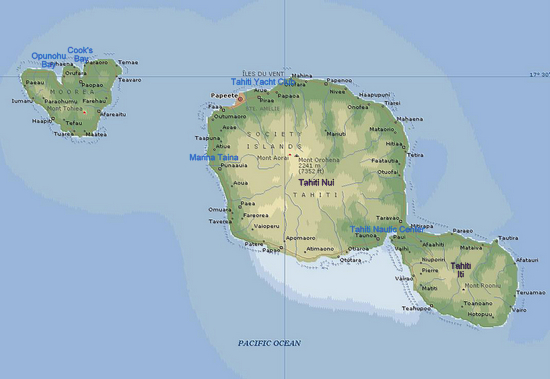 |
Our next stop was Point Venus, which is the location where Captain Cook camped to watch the planet Venus cross the sun on June 3, 1769. There's a park on this point with a lighthouse and a couple of monuments to other explorers. From here, we drove further along the northeast coast of Tahiti Nui. As we crossed over the Papenoo River, we stopped to check out the view up into the largest valley on Tahiti. We continued on to the Arahoho Blowhole, which was quite lively that day. Shortly after the blowhole, we stopped for a hike to the three beautiful Faarumai Falls. When we reached Taravao, we took a road up to a plateau on Tahiti Iti where we had beautiful views of Tahiti Nui and the peninsula connecting the two land masses. (On our way down from the plateau, along this road, we recognized Fano and Inga's home where we spent the morning of the tsunami warning.) On Tahiti Iti, we also visited the small towns of Tautira and Teahupoo. Tautira was a sleepy small residential area, but we found a good Chinese grocery store where we bought a couple of baguette sandwiches and sodas, and we ate our lunch at a picnic table on the beach. Teahupoo has a reputation for great surfing, but the big waves are offshore, so we didn't get a good view of them, but there we took a walk through a community which probably looks much the same as it did 50 years ago.
After our walk through Teahupoo, it was late afternoon, so we headed back to Papeete, which was 1˝ hours away. Having the car gave us the option of having dinner in the city, and we were looking forward to the nightly event of food vans (called "roulottes") serving dinner on the waterfront plaza - good food and a festive atmosphere!
|
|
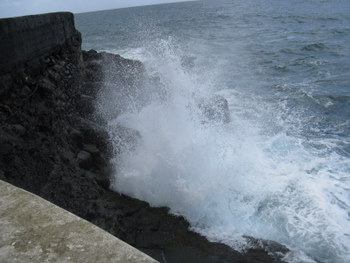 Arahoho Blowhole |
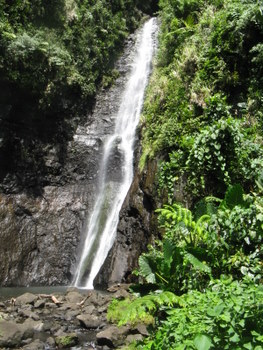 Haamaremare Rahi Falls |
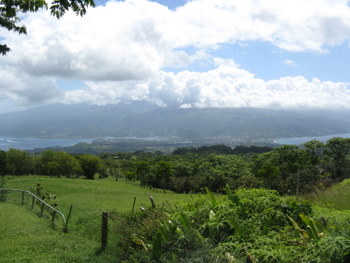 View of Taravao on the isthmus joining Tahiti Nui and Tahiti Iti |
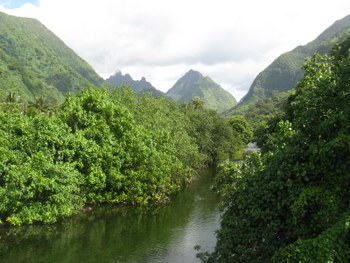 River valley on Tahiti Iti |
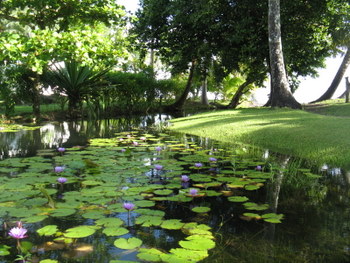 Pretty scenery in Teahupoo |
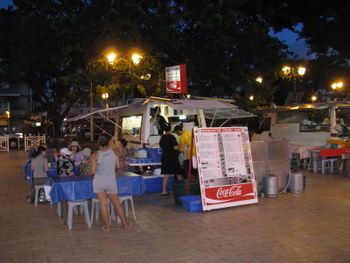 Dining at the roulottes in Papeete |
Final days on Tahiti (March 30-31). Early the next morning, Rich transferred the battery from the car to the boat (thank goodness we didn't forget that!), and then we drove back into Papeete. After dropping off the car, we walked by the Sin Tung Hing chandlery for a couple of small items, and then we stopped by the Port Captain/Gendarmerie offices to advise them we would be leaving Papeete and give them a general idea of our cruising plan. After that, we needed a snack, but this time Jan talked Rich out of McDonald's, and we stopped at a cafe for a cafe au lait and pastries - the brioche was fabulous! Now sated, we headed to the Papeete Market for a last bit of sightseeing and shopping.
The Papeete Market is held in a two-story building which takes up a full city block. On the ground floor, various merchants sell fruits and veggies, meats, fish and other foodstuffs. On the upper level, t-shirts, pareos, wood carvings, black pearls and other souvenirs are sold. We had fun looking at all the stuff for sale but ended up buying only a couple of t-shirts (and a couple of fruit tarts). After our shopping excursion, we caught the bus back to the Yacht Club.
|
|
|
By now, we were pretty much ready to move on from the island of Tahiti. We did one last load of laundry, topped off the water tank, gave away our old dinghy and ran to the grocery store a few more times, filling our fridge and freezer to capacity and topping off our supply of canned goods, dry goods and paper products.
| From Tahiti, our plan was to sail
to the island of Moorea, which is located 21 km (13 miles) northwest of Tahiti,
across a channel called the Sea of the Moon. We were looking forward to
spending some time exploring that island, while making sure all of Slip Away's
systems were functioning properly, and waiting for a weather window to sail to
the Tuamotu Archipelago, located a couple hundred miles to the east.
Opunohu Bay, Moorea (April 1-10). We departed from TYC late morning, and with the wind at our backs, we finally had an opportunity to sail Slip Away to her next port, Opunohu Bay on the north side of Moorea. Winds were fairly light and the seas a bit lumpy crossing the Sea of the Moon, so we didn't set any speed records, but we sailed it (22˝ miles, 5˝ hours). Moorea is an exceptionally beautiful island, and Opunohu Bay was apparently appealing to Hollywood because it was the backdrop in the film version of "South Pacific," and the 1984 remake of "The Bounty" was filmed here. When we pulled into Moorea, we were also eager to see some friends we met and sailed with last year - Steve & Heather on Kate. Shortly after we dropped our hook in Opunohu Bay, we invited them over to Slip Away, and we spent the evening imbibing a few spirits and catching up. While we were back in the U.S., Steve & Heather sailed to Penrhyn Atoll in the Cook Islands, where they spent some time before sailing back to French Polynesia. |
|
We spent the next ten days on Moorea - exploring some of the island, while making sure Slip Away was ready to venture further afield. We started up the watermaker and it ran fine. Our scuba compressor started on the first pull, and we topped off the scuba tank we used to clean the boat bottom a couple weeks earlier. Unfortunately, our freezer wasn't doing so fine. We had turned it on and filled it with frozen meats, shrimp and veggies on our last day at TYC, and although the items were still frozen, the freezer was struggling to keep them that way. Having experienced this problem in the past, we set off in search of an ice cream stand and found Mimi's Cafe just a short walk from the anchorage. The proprietors were very friendly and gave us the name and number of their refrigeration guy - David - who came out the next day, added some freon to our freezer, and then all was well. We thanked Mimi for her help by stopping by her cafe a couple of times for some of her delicious ice cream. Mimi spoke English quite well and told us that she had traveled to the U.S., visiting Los Angeles, New York, and Dayton, Ohio (of all places!).
We did some snorkeling, which wasn't exceptional, but the water was clear, there was some good fish life, and it was nice to have our faces back in the water. We also did a great hike to the "Belvedere," a lookout with views of Opunohu and Cook's Bays. Along this route, we also stopped by and explored a small portion of the Marae Titiroa (ancient Polynesian temples) and dropped in at the Lycee Professioinel Agricole (Moorea's agricultural high school), which farms hundreds of acres planted with pineapples, vanilla, coffee, fruit trees, flowers and vegetables. We showed up too late in the day to do one of the free tours given by the agricultural school, but we sampled some of their organic jams and bought a jar of pineapple/vanilla. The scenery along this hike was gorgeous, with great views of the peaks that make Moorea such a beautiful island. Also, the flora on this island is incredible with many varieties of flowers growing wild all over the island. At the end of this page are some photos of the beautiful flowers.
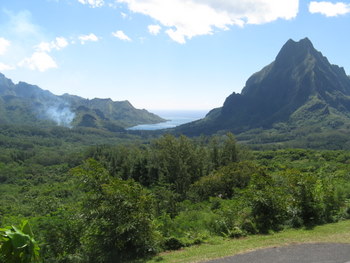 View of Opunohu Bay from the Belevedere |
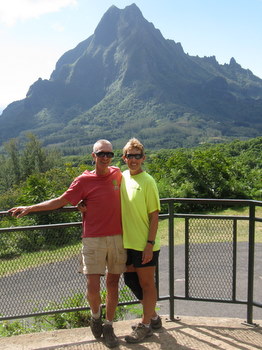 The two of us in front of Mt. Rotui (899 meters, 2950 feet high) |
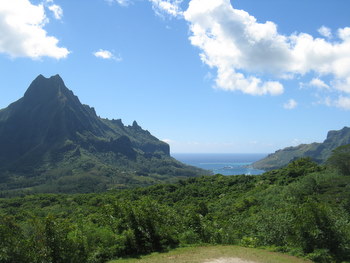 View of Cook's Bay from the Belvedere |
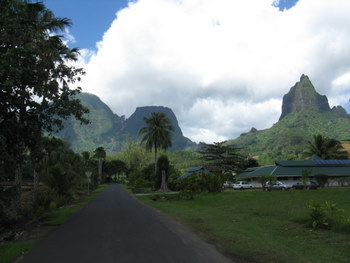 Moorea's peaks visible on the hike to the Belvedere |
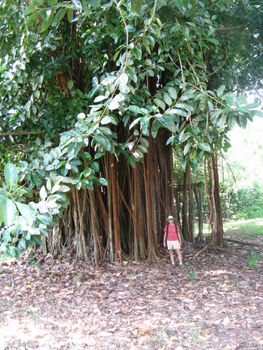 Rich beside a huge banyan tree |
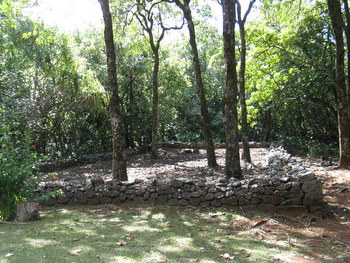 Archery platform at Marae Titiroa |
| We also had great fun with our friends Steve & Heather
from Kate. We shared several dinners,
including a couple of beach barbeques and a Mexican food night with margaritas.
We exchanged information on favorite anchorages and destinations - mostly
we were the beneficiaries of information on anchorages from Steve & Heather
because they had already been to several of the places we intended to visit in the
next few months. We chatted about friends and other characters we've
met along the way, reminisced about the fun we had last year, and talked about
future cruising plans. We swapped books, took walks and ran errands together. There
aren't a lot of cruising boats in French Polynesia at this time of year, so both
they and us had spent quite a bit of time on our own over the past few months.
We really enjoyed this opportunity to spend time with Heather & Steve and
get to know them better. Moorea was an easy place to hang out for a while, and we could have stayed longer, but we saw a good break in the weather. We were headed to the Tuamotus from Moorea, and depending which atoll one sails to, the passage is 200-300 nautical miles against the prevailing tradewinds. Slip Away is a shallow-draft full-keel boat, so she doesn't go to weather very well. Steve & Heather had done a few upwind passages on Kate over the past few months, and they weren't very keen on them. Kate sails much better than Slip Away in those conditions, but sailing to windward is rarely comfortable. The weather forecast was calling for a few days of very light winds, and we decided this was our opportunity. We would likely end up motoring most of the way to the Tuamotus - it was not the most cost efficient way to get there, but it would be the most time efficient, and easier on the boat and crew. |
|
After spending ten days in Moorea, our weather window arrived. On the morning of our departure, along the north coast of Moorea, we had light west-northwest winds - ideal for our eastbound passage. We prepared Slip Away for passage, bade good-bye to Steve & Heather (looking forward to our paths crossing again in the future), took a few last looks at the beautiful island of Moorea, weighed anchor, and headed out.
________________________________________________________________________________________
Here are a few of the flowers we saw growing wild on Moorea. We don't know the names of them, but we thought they were lovely..
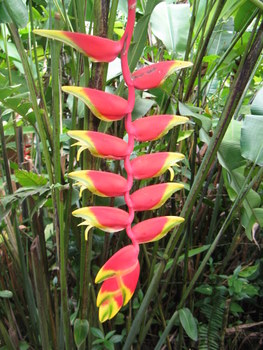 |
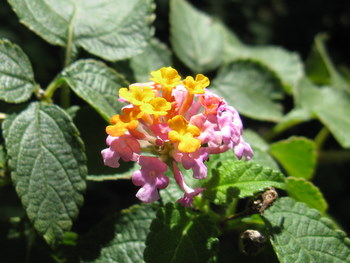 |
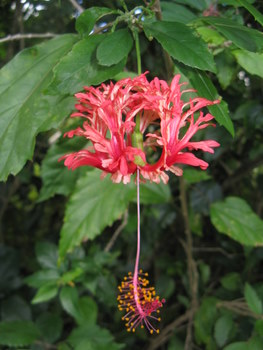 |
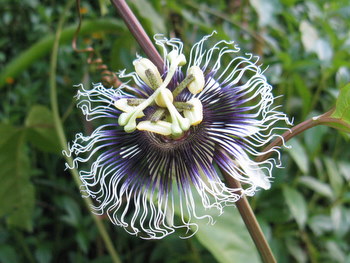 |
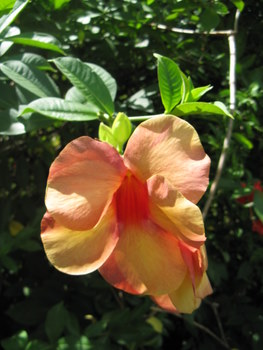 |
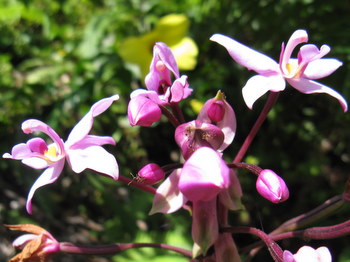 |
